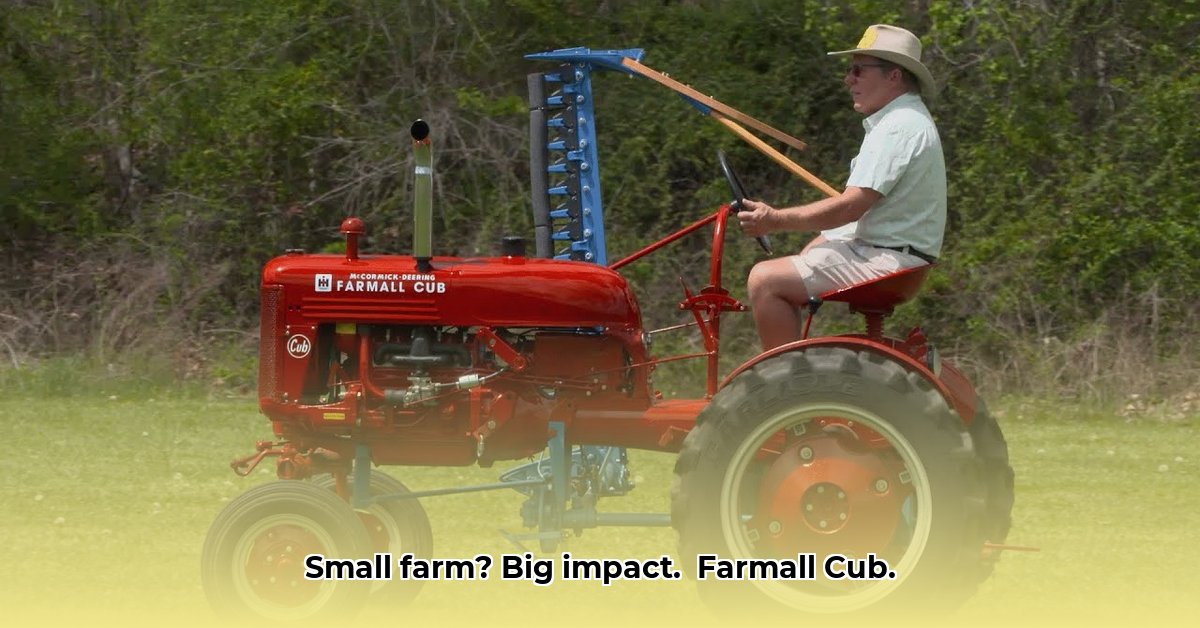
A Legacy of Efficiency: The Farmall Cub's Enduring Appeal
The Farmall Cub, introduced in 1947, wasn't just another tractor; it was a revolution. Its compact design, coupled with the innovative "Culti-Vision" offset engine placement, made it ideal for smaller farms, a significant advantage in an era dominated by family-run operations. Over 200,000 units produced speaks volumes about its enduring success. But how does this little tractor, a symbol of a bygone era, fit into the modern conversation about sustainable agriculture? Its surprising relevance lies in its resourcefulness and remarkable durability. This article explores the Farmall Cub's historical context, technical specifications, sustainability advantages (and disadvantages), practical applications, and potential for modern adaptations within the context of sustainable small-scale farming. For more on similar models, see the Farmall W4 information.
A Blast from the Past: History and Design
Before delving into the specifics, consider the Farmall Cub's historical context. Imagine a time when farming relied heavily on human ingenuity and physical labor. The Cub, with its charmingly compact design, was designed to be a farmer's constant companion. Its maneuverability, a direct result of its smaller size, was particularly valuable on smaller plots of land where space was at a premium. The quiet hum of its engine became the soundtrack of countless family farms, its presence a comforting constant in fields across the nation.
Under the Hood: Technical Specifications and Performance
The Farmall Cub's L-head engine, while possessing a distinct character, exhibited a fuel efficiency of 8.6 horsepower hours per gallon during drawbar work—a figure remarkably efficient for its time, as confirmed by Nebraska Tractor Tests. Let's compare that to modern counterparts:
| Feature | Farmall Cub | Modern Compact Tractor |
|---|---|---|
| Horsepower | 13-14 HP | 25-40 HP |
| Fuel Efficiency | Exceptional for its era | Significantly improved |
| Size | Compact, Highly Maneuverable | Compact to mid-sized, varied |
| Emissions | Higher, typical for its time | Significantly reduced |
| Maintenance | Requires specialized knowledge | Generally easier, more standardized |
| Parts Availability | Can be challenging, but resources exist | Widely available |
While modern tractors offer superior horsepower and significantly improved fuel efficiency and reduced emissions, the Cub's compact size minimizes soil compaction—a critical aspect of soil health and sustainable farming. Its smaller footprint translates to less soil disturbance, fostering better soil structure and fertility. However, its lower power output naturally limits its capabilities compared to modern tractors, thereby influencing its suitability for various tasks.
Sustainability Analysis: A Timeless Goal, Redefined
While the Farmall Cub wouldn't be considered "green" by today's standards, its design embodies elements of sustainable practices. Its fuel efficiency minimized fuel consumption, directly reducing its carbon footprint for its time. Its long lifespan, coupled with the still-available (though sometimes challenging to find) parts, reduces waste. However, its manufacturing processes and materials weren't designed with modern environmental concerns in mind, reminding us that the definition of "sustainable" evolves with technological advances and a deeper understanding of environmental implications. The low-impact nature of the Cub highlights a core tenet of sustainable agriculture: maximizing output while minimizing resource depletion.
Practical Applications and Maintenance: Keeping the Cub Running
A well-maintained Farmall Cub can still prove incredibly useful on today's small farms. Its strengths lie in tasks requiring maneuverability and precision. Ideal applications include:
- Pasture Mowing: Its compact size excels in navigating uneven terrain.
- Cultivating Smaller Gardens: Perfect for tilling smaller plots.
- Operating Light Implements: Compatible with simple implements like small plows or cultivators.
However, its lower horsepower limits its suitability for heavier tasks. Choosing suitable tasks is paramount.
Maintaining a Farmall Cub requires a different approach than modern tractors. It demands care and some mechanical aptitude. Here’s a streamlined maintenance plan:
- Regular Oil Changes: Essential for engine longevity. Follow recommended intervals.
- Cooling System Checks: Regularly inspect for leaks or blockages.
- Lubrication: Keep moving parts well-lubricated.
- Parts Sourcing: Finding parts may require more effort, utilizing vintage tractor suppliers or online communities.
While sourcing parts can be more involved, the availability of resources within dedicated communities and online marketplaces ensures that maintaining a Farmall Cub remains attainable.
Modern Adaptations and Upgrades: Bridging the Gap
The Farmall Cub is not limited by its vintage design. Several modern enhancements can significantly expand its capabilities:
- Three-Point Hitch: Expands implement compatibility.
- Electric Conversion: A more complex undertaking, but would drastically reduce emissions.
The possibility of adapting the Farmall Cub to modern technologies underscores its potential as a sustainable farming tool well into the future.
Conclusion: A Sustainable Future, One Cub at a Time
The Farmall Cub, despite its age, offers a compelling case study in sustainable agricultural practices. Its durability, relatively low environmental impact for its time, and adaptability, especially through modern upgrades, make it a relevant player in small-scale sustainable farming. Its legacy underscores the importance of resource efficiency and responsible land management in the long-term sustainability of agriculture. As we look toward the future, carefully considered adaptations of vintage machinery, like the Farmall Cub, offer a unique and potentially significant approach to sustainable practices.